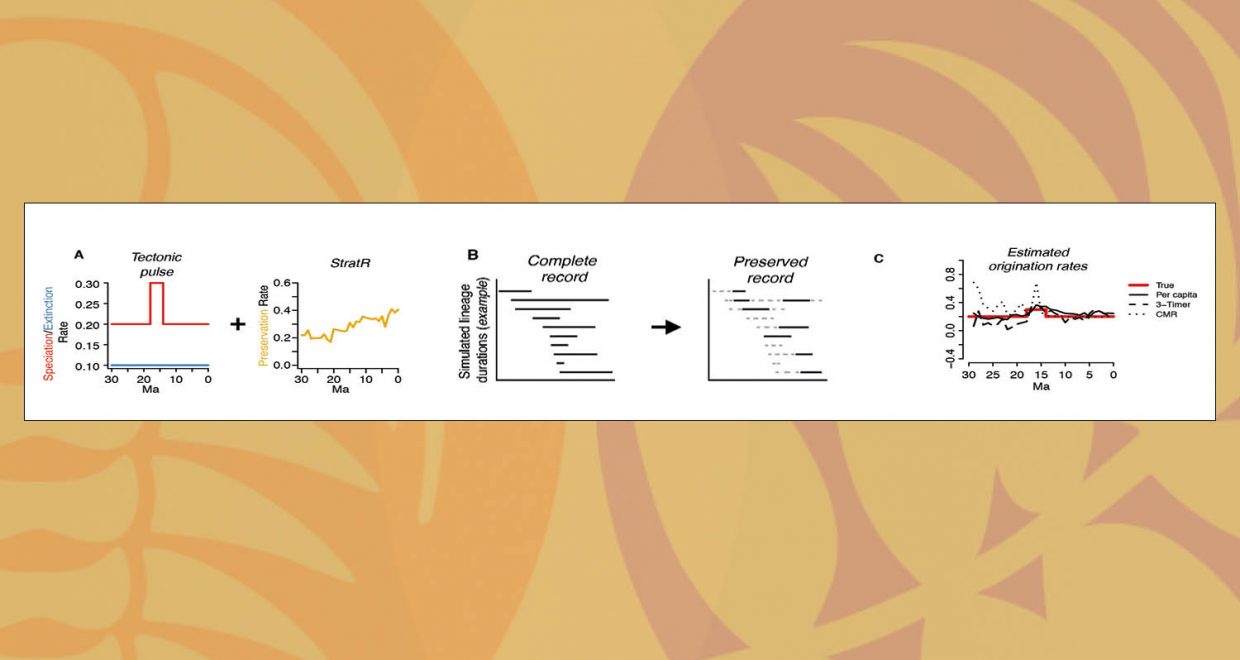Testing the fossil record: how simulations help us understand the relative roles of diversification and preservation underlying diversity gradients in deep time
Biodiversity hotspots and gradients are a striking feature across the globe today. While the Latitudinal Diversity Gradient is the best known of these biodiversity patterns, strong gradients in species richness also exist in relation to topography and habitat heterogeneity. Increased diversity in mountainous regions compared to adjacent low-relief regions has been observed for mammals, birds, and plants and is known as the Topographic Diversity Gradient (TDG). North American small mammals provide an excellent example of the TDG today: rodent species richness rises steeply from the Great Plains into the Rocky Mountains, and high taxonomic and ecological diversity characterizes communities across the tectonically active Basin and Range Province. However, evidence from the fossil record shows that the small-mammal TDG has come and gone over the past 30 million years. Understanding the waxing and waning of diversity gradients over deep time provides insight into important biogeographic processes and how they relate to rapid or gradual tectonic and climate change. As a paleobiologist, I am interested in disentangling the processes underlying the proliferation, extinction, and immigration of species across topographically complex landscapes.
Paleontologists have long sought to track the rise and fall of diversity over geologic time. While paleontological findings have fundamentally shaped our understanding of the history of life on Earth, a constant challenge in this endeavor is the inherent incompleteness of the fossil record. The fossil record provides direct evidence for past lineages; however, variation in the preservation of this record across space and time can hinder our ability to accurately read it. In response to this challenge, paleontologists have come up with many creative and robust ways to evaluate diversity in the past and jointly estimate the speciation and extinction rates of lineages through time. In parallel with large and comprehensive online databases for fossil occurrences, advances in our ability to track the diversification of fossil lineages now enable researchers to test many compelling hypotheses. Allowing and accounting for variation in preservation through time remains a key component in this process.
In this paper, I integrated data from the rodent fossil and terrestrial rock records of North America with the Neogene tectonic history of the topographically complex Basin and Range as a case study of the TDG over geologic time (Smiley 2018). Furthermore, I tested several hypotheses for how preservation influences our ability to accurately read this fossil record using three well-known methods for estimating diversification dynamics: per capita, three-timer, and capture-mark-recapture rate estimates.
To do so, I simulated fossil records under several different diversification and preservation scenarios. As an example, I hypothesized that Basin and Range tectonic extension breaking up the landscape of western North America 18 to 14 million years ago led to an increase in speciation rates. Alone, this pulse in elevated speciation rates would have produced the strong TDG we observe during this time period. However, changes in the availability of the rock record through time may accentuate, dampen, or even erase this pattern. Simulating fossil records under the combined effects of both time-heterogeneous speciation and preservation rates enabled me to distinguish under which scenarios our current metrics do an adequate or inadequate job revealing the true underlying diversification dynamics of fossil faunas. While the fidelity of the record suffers during intervals of rapid or extreme changes in preservation probability, the take home message from most of the simulations is that we can reliably capture diversification dynamics using current statistical approaches, with one important caveat: researchers must be cognizant of the role preservation plays in driving patterns observed in the fossil record and make informed decisions about which metrics are best suited for their data.
While this research is far from the first to make this point, I illustrate how testing fossil data using different preservation hypotheses, including those generated from independent lines of evidence (e.g., areal extent of the rock record) can be illuminating. This research also increases our confidence that variation in the North American rodent TDG through time is a robust pattern demanding biological explanation. Revealing how past diversity has changed in response to major events in Earth history provides the foundation for understanding the generation and maintenance of biodiversity patterns today and into the future.
The full paper “Detecting diversification rates in relation to preservation and tectonic history from simulated fossil records” by Tara M. Smiley has been published Open Access in Paleobiology and can be viewed here.
Read other blog posts from Paleobiology here.
or view all blog posts from the Paleontological Society Journals






